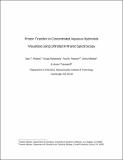Proton Transfer in Concentrated Aqueous Hydroxide Visualized using Ultrafast Infrared Spectroscopy
Author(s)
Roberts, Sean Thomas; Ramasesha, Krupa; Petersen, Poul B.; Mandal, Aritra; Tokmakoff, Andrei
DownloadTokmakoff-Proton Transfer in Concentrated.pdf (407.7Kb)
PUBLISHER_POLICY
Publisher Policy
Article is made available in accordance with the publisher's policy and may be subject to US copyright law. Please refer to the publisher's site for terms of use.
Terms of use
Metadata
Show full item recordAbstract
While it is generally recognized that the hydroxide ion can rapidly diffuse through aqueous solution due to its ability to accept a proton from a neighboring water molecule, a description of the OH− solvation structure and mechanism of proton transfer to the ion remains controversial. In this report, we present the results of femtosecond infrared spectroscopy measurements of the O−H stretching transition of dilute HOD dissolved in NaOD/D2O. Pump−probe, photon echo peak shift, and two-dimensional infrared spectroscopy experiments performed as a function of deuteroxide concentration are used to assign spectral signatures that arise from the OH− ion and its solvation shell. A spectral feature that decays on a 110 fs time scale is assigned to the relaxation of transiently formed configurations wherein a proton is equally shared between a HOD molecule and an OD− ion. Over picosecond waiting times, features appear in 2D IR spectra that are indicative of the exchange of population between OH− ions and HOD molecules due to deuteron transfer. The construction of a spectral model that includes spectral relaxation, chemical exchange, and thermalization processes, and self-consistently treats all of our data, allows us to qualitatively explain the results of our experiments and gives a lower bound of 3 ps for the deuteron transfer kinetics.
Date issued
2011-02Department
Massachusetts Institute of Technology. Department of ChemistryJournal
Journal of Physical Chemistry A
Publisher
American Chemical Society
Citation
Roberts, Sean T. et al. “Proton Transfer in Concentrated Aqueous Hydroxide Visualized Using Ultrafast Infrared Spectroscopy.” The Journal of Physical Chemistry A 115.16 (2011): 3957–3972.
Version: Author's final manuscript
ISSN
1089-5639
1520-5215